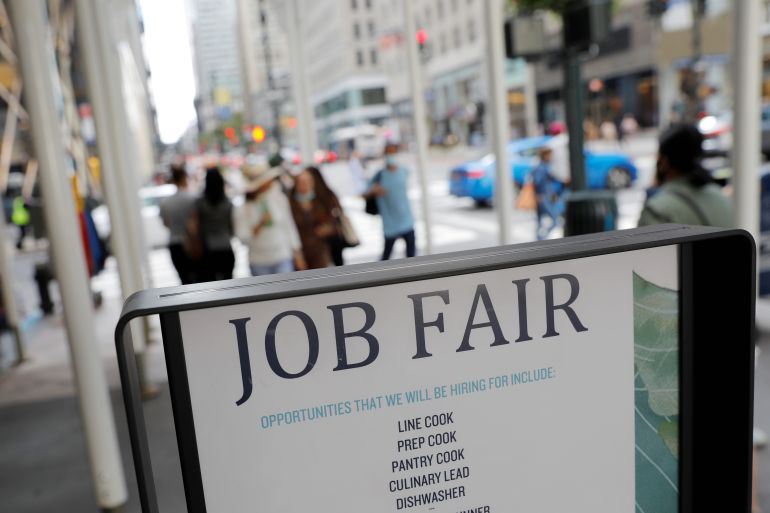Layoffs revised up in January but US labour market still strong
Even as layoffs rose in January and job cuts were higher than initially thought in 2022, job market remains strong with 1.9 opening per every unemployed worker.

US job openings fell less than expected in January and data for the prior month was revised higher, pointing to persistently tight labour market conditions that likely will keep the Federal Reserve on track to raise interest rates for longer.
But the United States Labor Department’s monthly Job Openings and Labor Turnover Survey, or JOLTS report, on Wednesday also hinted at some cracks forming in the labour market. Layoffs rose in January and job cuts were higher than initially thought in 2022. Fewer people voluntarily quit their jobs.
Keep reading
list of 4 itemsIn Russia, children opposing the Ukraine war are being targeted
Debut launch of world’s first 3D-printed rocket called off
US investigation finds police abuse, discrimination in Louisville
Nevertheless, the labour market has remained strong, with 1.9 job openings per every unemployed worker in January. Fed Chair Jerome Powell told lawmakers on Tuesday that the US central bank would likely need to raise rates more than expected and he opened the door to a half-percentage-point increase this month to combat inflation after a recent series of strong economic data.
“The decline in job openings does not indicate any meaningful improvement in the balance between labour demand and labour supply from the perspective of the Fed,” said Conrad DeQuadros, senior economic adviser at Brean Capital in New York.
Job openings, a measure of labour demand, decreased by 410,000 to 10.8 million on the last day of January. Data for December was revised higher to show 11.2 million job openings instead of the previously reported 11 million. Economists polled by Reuters had forecast 10.5 million job openings.
The report also showed job openings were mostly higher than initially estimated in 2022, averaging 11.2 million, an increase of 1.2 million from 2021.
The decline in January, which was across all four regions, was led by construction, with 240,000 fewer job openings. Vacancies decreased by 204,000 in accommodation and food services, and fell by 100,000 in the finance and insurance industry.
Employment in the leisure and hospitality industry, which covers accommodation and foods services, has remained below its pre-pandemic level. This sector has been the biggest driver of job growth.
Job openings increased in transportation, warehousing and utilities as well as nondurable goods manufacturing.
The job openings rate fell to a still-high 6.5 percent from 6.8 percent in December. It averaged 6.8 percent in 2022, up from 6.4 percent in 2021.
Hiring rose to 6.4 million from 6.3 million in December. The hires rate increased to 4.1 percent from December’s 4 percent. There were 77.2 million hires in 2022, a gain of 1.2 million from 2021. The hires rate averaged 4.2 percent in December, down from 4.3 percent in 2021.
Layoffs jumped 241,000 to 1.7 million, concentrated in the professional and business services industries. Layoffs, however, decreased in federal government. They increased 461,000 in 2022 to 17.6 million. Still, they remain low by historical standards.
About 3.9 million people quit their jobs, down 207,000 from December. The decline was mostly in professional and business services, educational services and the federal government. A record 50.6 million people quit in 2022.
“Last year’s labour market may not have been as advantageous to workers as we thought, as quits were revised down and layoffs were revised up,” said Nick Bunker, head of economic research at Indeed Hiring Lab. “But by any standard, both measures showed a tight, hot labour market.”
US stocks were mixed. The dollar was little changed against a basket of currencies. US Treasury prices rose.
Private payrolls rise
Labour market strength was reinforced by the ADP National Employment report, which showed private employment increased by 242,000 jobs in February after rising 119,000 in January. Economists had forecast private employment increasing 200,000.
Job growth was robust in January, with the unemployment rate falling to a more than 53.5-year low of 3.4 percent. Consumer spending rebounded strongly and inflation picked up in January.
The ADP report showed hiring continuing to be concentrated in the services sector, which added 190,000 jobs last month, most of them in the leisure and hospitality industry.
There were also gains in the financial activities, education and health services, information, and trade, transportation and utilities industries. But professional and business services shed 36,000 jobs. The goods-producing sector added 52,000 jobs, with manufacturing creating 43,000 positions. But construction payrolls decreased by 16,000 jobs.
According to a Reuters survey of economists, nonfarm payrolls are forecast rising by 205,000 jobs last month after surging 517,000 in January.